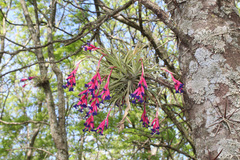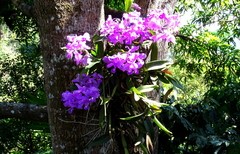Epiphytes

Overview
Epiphytes, specifically vascular epiphytes, are those plants that germinate and take root on other plants. These plants generally exhibit commensal relationships with their host plants, and epiphytes can be both obligate and facultative [2]. Facultative epiphytes are plant species that grow terrestrially and epiphytically approximately the same amount across their distribution. If a species grows epiphytically at least 95 percent of the time, it is considered an obligate epiphyte [3]. Plants that grow on other plants for only a portion of their life cycle are referred to as "hemi-epiphytes" [4]. Additionally "accidental epiphytes" can occur when a plant that does not usually grow epiphytically at any point in its life cycle does [2]. Globally, epiphytes account for approximately 10 percent of all plant diversity. It is estimated that over 24,000 vascular plants are considered to be epiphytes, and these plants are most commonly concentrated in tropical areas, where they provide significant ecosystem services [4].
Ecology and Evolution
Ecologically, epiphytes are opportunistic, and most plants can display epiphytic growth in the correct conditions. Most epiphytes grow in tree crowns. Accidental epiphytes result from a species taking advantage of available resources in a microhabitat. In these cases, a plant species may have a fundamental niche in which it can grow epiphytically but is usually not able to due to competition or lack of resources [3].
Evolutionarily, epiphytism has been described as plants with adaptations to canopy conditions taking advantage of empty space [3]. Epiphytism and its traits is also thought to have led to rapid diversification in certain plant families. For example, 75 percent of the family Orchidaceae and 59 percent of the family Bromeliaceae are epiphytic [5].
Epiphytes additionally have many unique adaptations in their growth that help to retain ecosystem stability. For instance, epiphyte habitats are usually considered to be discontinuous, and because of their common habitat in canopies, this means that their seeds are usually dispersed via wind or birds. Additionally, these plants require roots that are specially designed to grow in areas that do not contain soil. This unique growth system also means that epiphytes need to be well-adapted to absorbing rainwater, as they cannot access water through soil. Epiphytes also have to be smaller and lighter in size and weight in order to not pressure the plant they grow on and cause stress or possible dislodgement. Along with this, epiphytes need to have leaves adapted to light conditions of canopies and a structure that is able to retain water in times of stress [6].
Common Vascular Epiphytes
Orchids

The orchid family (Orchidaceae) is one of incredible diversity. These plants can either grow terrestrially or epiphytically (relying on trees for this growth). Precipitation and water levels typically determine if orchids will grow epiphtically, and warmer temperatures often correlate to epiphytic growth in orchids. Therefore, they tend to display this growth strategy in the humid climate of tropical areas. When orchids display epiphytic growth, their leaves tend to become thick and their aerial roots become covered in a layer of dead skin cells. These adaptations help the plant to better conserve and absorb water. Other adaptations of epiphytic orchids include having pseudobulbs that help retain water and practicing CAM photosynthesis [7].
Bromeliads
Ferns
References
- ↑ 1.0 1.1 1.2 iNaturalist. https://www.inaturalist.org/.
- ↑ 2.0 2.1 2.2 Zotz, Gerhard. (12 Nov 2012). "The systematic distribution of vascular epiphytes – a critical update." Botanical Journal of the Linnean Society. The Linnean Society of London. 171: 453–481. https://academic.oup.com/botlinnean/article/171/3/453/2416203.
- ↑ 3.0 3.1 3.2 3.3 Hoeber, V. and Zotz, G.. (15 Mar 2022). "Accidental epiphytes: Ecological insights and evolutionary implications." Ecological Monographs. The Ecological Society of America. 92(4): e1527. https://doi.org/10.1002/ecm.1527.
- ↑ 4.0 4.1 4.2 Nieder, J., Prosperi, J., Michaloud, G.. (2001). "Epiphytes and their contribution to canopy diveristy." Plant Ecology. Kluwer Academic Publishers. 153: 51-63. https://www.researchgate.net/publication/226617674_Epiphytes_and_their_contribution_to_canopy_diversity.
- ↑ 5.0 5.1 Taylor, A., Zotz G., Weigelt P., Cai L.,Karger D. N., König C., & Kreft H. (2022). "Vascular epiphytes contribute disproportionately to global centres of plant diversity." Global Ecology and Biogeography, 31: 62–74. https://doi.org/10.1111/geb.13411.
- ↑ 6.0 6.1 Hietz, P., Wagner, K., Nunes Ramos, F.,Cabral, J. S., Agudelo, C., Benavides, A. M., Cach-Pérez, M. J.,Cardelús, C. L., Chilpa Galván, N., Erickson Nascimento daCosta, L., de Paula Oliveira, R., Einzmann, H. J. R., de PaivaFarias, R., Guzmán Jacob, V., Kattge, J., Kessler, M., Kirby, C.,Kreft, H., Krömer, T., … Zotz, G. (2022). "Putting vascular epiphytes on the traits map." Journal of Ecology, 110: 340–358. https://doi.org/10.1111/1365-2745.13802.
- ↑ 7.0 7.1 Taylor, A., Keppel, G., Weigelt, P., Zotz, G., Kreft, H.. (2021). "Functional traits are key to understanding orchid diversity on islands." Ecography. 44: 703–714. http://dx.doi.org/10.1111/ecog.05410.